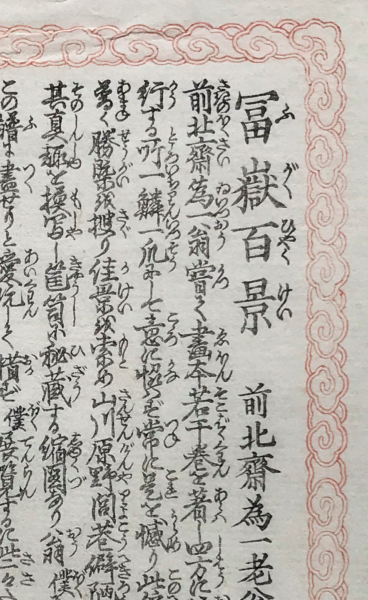As the advert for the Thirty-six Views of Mount Fuji appeared in the 1st Month of 1831 in Part 12 of Ryūtei Tanehiko’s 柳亭種彦 (1783-1842) Shōhon jitate『正本製』, it was indicated that what we now usually read as Fugaku 富嶽 should be read as ‘Fuji.’ It is now difficult to know whether this was meant to help the public that might have some problem with the reading of the less common character 嶽, or whether it was, indeed, Hokusai’s or the publisher’s idea that we should read the series-title 富嶽三十六景 as Fuji sanjūrokkei.
The problem – or the question at least – comes up again in 1834 when the first part of his One Hundred Views of Mount Fuji is published, where we similarly, and correctly, usually transcribe the title 富嶽百景 as Fugaku hyakkei. That this is correct can be inferred from the small leaflet that the publishers issued in the Autumn of 1833, announcing the forthcoming album 冨嶽百景 with the indication in furigana that this should be read as ふがくひやくけい, Fugaku hyakkei that is, by ’the Old Man Iitsu formerly Hokusai’ 前北斎為一老翁 to be transcribed as saki no Hokusai Iitsu rōō.

It cannot be doubted that Ryūtei Tanehiko in his preface to the Fugaku hyakkei Part 1 knew that Hokusai used the characters 不二, to be read as Fuji, but literally meaning ’not’ and ‘two,’ or ‘second to none,’ often also translated as ‘peerless,’ for each of the titles of his plates. Indeed, also Tanehiko refers to the mountain as Second to None.
Interestingly, Hokusai used this spelling of the mountain’s name also in the prints in the final instalment of his Thirty-six Views of Mount Fuji series – the ten prints that all have a line-block printed in black from the start. These are Minobugawa ura Fuji 身延川裏不二; Tōkaidō Shinagawa Atagoyama no Fuji 東海道品川御殿山ノ不二; Senju kagai yori chōbō no Fuji 従千住花街眺望ノ不二; and Tōkaidō Kanaya no Fuji 東海道金谷ノ不二 . It would even seem that these five prints were the last five designs that he made, not only introducing the spelling of Fuji as Second to None, as in the Fugaku hyakkei volumes, but also indicating for the first time in the titles of the series, that it was the ‘Second-to-None Mountain’ seen from here, or seen there. Until then, the mountain was not mentioned in any of the preceding fourty-one print titles.
This also corroborates that the last instalment of the Fuji series coincides with Hokusai working on his One Hundred Views of Mount Fuji albums, in 1833 or 1834.